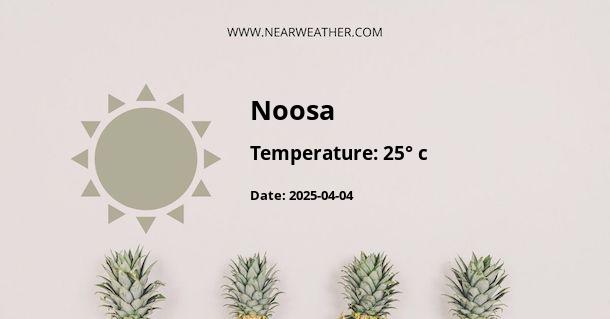Weather
25° 
Climate Conditions: overcast clouds
Humidity: 80%
Wind speed: 27.65 km/h
Wind direction: 168°
Daily Weather Forecast
Friday
04/04/2025
Climate Conditions: light rain
Humidity: 80%
Saturday
04/05/2025
Climate Conditions: scattered clouds
Humidity: 84%
Sunday
04/06/2025
Climate Conditions: light rain
Humidity: 81%
Monday
04/07/2025
Climate Conditions: clear sky
Humidity: 75%
Tuesday
04/08/2025
Climate Conditions: moderate rain
Humidity: 78%
Evolution
Daily Weather Forecast Evolution (°C)
Lowest temperature
Highest temperature
Other Information
Sunrise
05:57
Sunset
17:42
Latitude
-26.383329
Longitude
153.149994
Timezone: GMT+05:30
More about Noosa:
Noosa Heads, Australia: Climate and Weather Year Round
Noosa Heads, located in Queensland, Australia, is a popular tourist destination known for its stunning natural beauty and vibrant coastal lifestyle. One of the key factors that attracts visitors to this region is its pleasant climate and favorable weather conditions throughout the year. In this article, we will explore the climate patterns of Noosa Heads, providing detailed information about temperature, precipitation, and other weather-related aspects that make it an ideal destination for outdoor activities and relaxation.Temperature
Noosa Heads experiences a typical subtropical climate, characterized by mild winters and warm summers. The average annual temperature in this region ranges from 17°C (62.6°F) to 27°C (80.6°F), making it a desirable location for those seeking a warm and pleasant climate. Here's a breakdown of the monthly average temperatures:| Month | Average Temperature (°C) |
|---|---|
| January | 27°C |
| February | 27°C |
| March | 26°C |
| April | 24°C |
| May | 21°C |
| June | 18°C |
| July | 17°C |
| August | 18°C |
| September | 20°C |
| October | 22°C |
| November | 24°C |
| December | 26°C |
Precipitation
Noosa Heads experiences a moderate level of precipitation throughout the year, with the wettest months occurring during the summer season. The annual average rainfall in this region is approximately 1,400 millimeters (55 inches). Here's a breakdown of the monthly average rainfall:| Month | Average Rainfall (mm) |
|---|---|
| January | 156mm |
| February | 174mm |
| March | 197mm |
| April | 141mm |
| May | 116mm |
| June | 77mm |
| July | 59mm |
| August | 38mm |
| September | 48mm |
| October | 71mm |
| November | 94mm |
| December | 137mm |
Sunshine Hours
Noosa Heads is known for its abundance of sunshine throughout the year. The region enjoys an average of 300 sunny days annually, providing ample opportunities for outdoor activities and beach lounging. On average, Noosa Heads receives approximately 7 hours of sunshine per day.Seawater Temperature
The coastal location of Noosa Heads offers visitors the chance to enjoy the pristine waters of the Pacific Ocean. The temperature of the seawater in this area varies throughout the year, influenced by the seasons. Here's a breakdown of the monthly average seawater temperatures:| Month | Average Seawater Temperature (°C) |
|---|---|
| January | 26°C |
| February | 26°C |
| March | 25°C |
| April | 24°C |
| May | 22°C |
| June | 20°C |
| July | 19°C |
| August | 19°C |
| September | 20°C |
| October | 22°C |
| November | 23°C |
| December | 25°C |
Best Time to Visit
Noosa Heads is an all-year-round destination with favorable weather conditions for most outdoor activities. However, the best time to visit may depend on personal preferences and the type of activities you plan to engage in. The peak tourist season in Noosa Heads typically occurs during the summer months (December to February), when the weather is warm, and the seawater temperature is ideal for water-based activities. If you prefer fewer crowds and milder temperatures, the spring season (September to November) and the autumn season (March to May) can be excellent times to visit. During these months, the weather is generally pleasant, and the region experiences less rainfall compared to the summer months.Conclusion
Noosa Heads, Australia, offers a pleasant subtropical climate with mild winters, warm summers, and an abundance of sunshine. The region experiences a moderate level of rainfall, with the wettest months occurring during the summer season. The seawater temperature varies throughout the year, being warmest during the summer months and cooler during winter. Whether you prefer beach activities, outdoor adventures, or simply enjoying the stunning natural beauty, Noosa Heads provides a favorable climate year-round, making it an ideal destination for visitors seeking a coastal paradise.FAQ's about Noosa's Weather:
Q - What is the Latitude and Longitude of Noosa?
A - Noosa's Latitude is -26.383329 & Longitude is 153.149994.
Q - What is the weather in Noosa today?
A - Weather in Noosa is 25° today.
Q - What is the climatic condition of Noosa today?
A - Climate Conditions in Noosa shows overcast clouds today.
Q - What is the humidity in Noosa today?
A - Humidity in Noosa is 80% today.
Q - What is the wind speed in Noosa today?
A - Wind speed in Noosa is 27.65 km/h, flowing at 168° wind direction. today.

Nearby Locations
Latest searched locations